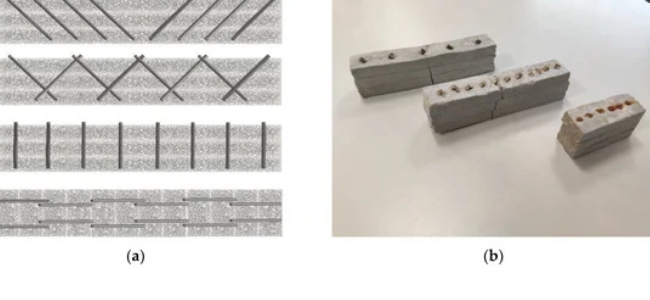Researchers from France and the UK seek ways to improve 3D printing for construction, revealing their analysis in the recently published ‘Nailing of Layers: A Promising Way to Reinforce Concrete 3D Printing Structures.’
Concrete extrusion is a continuing source of innovation for the construction industry, lending promise to 3D printed offices, homes, and entire village concepts—as well as added potential for more affordable housing. Greater affordability, speed in production, less need for manpower, and the ability to create composites for better performance are just a few of the benefits.
“Recent research on 3D printing has almost all been focused on mix-design, rheological and process related issues. It has allowed the production of a physically-based background in order to formulate concrete with the required fresh properties, and allowed us to evaluate a time window during which it is possible to deposit a new layer of cement-based material,” stated the researchers.
“Nowadays, some technical solutions have emerged in the development of successful concrete printing, and researchers have started to work on the structural performances of reinforced and unreinforced concrete printed structures.”
Additional reinforcements are the only way for some structures, including infrastructure like bridges, to adhere to standards in design. Contemporary solutions may include steel reinforcements or the use of cables, or fibers made of the following materials:
- Steel
- Basalt
- Glass
- Bio-based materials
- Polymeric fibers
In this study, the scientists experimented with the use of nails, driven through several layers after they were 3D printed. The overall goal was to offer ductility, tensile, and shear strength—while also offering greater strength in between layers.
“This strategy can be easily automated using a robotic placement of the nail which can be a real advantage and beneficial in the context of digital construction,” stated the researchers.
Placement of nails was studied regarding gradient of mechanical properties, along with evaluating reinforcement effects through three-point flexural tests examining orientation, surface roughness, and steel density.
Three-layer samples and ten-layer samples were fabricated with 10 × 25 mm² rectangular cross section layers of mortar with a screw extrusion system mounted on a WASP 3MT Industrial 4.0 printer.
Bending resistance was tested, along with post-peak behavior, and the potential for durability issues and corrosion of steel. Numerous issues must be considered to avoid corrosion, beginning with permeability, as it must be ‘the lowest possible’ to decrease carbonation and any resulting corrosion. Covers must be used to protect steel, with other materials like fly ash or granulated slag preventing steel nail corrosion. Other solutions include using stainless steel, glass, basalts, or carbon to avoid corrosion.
“It was also demonstrated that reinforcement, by using nails, was able to efficiently strengthen printed samples if the orientation of the nails was correctly chosen and the nails surface was sufficiently rough to ensure a good interface with the mortar,” said the researchers.
“In conclusion, this investigation paved a new path towards fully automated selective steel nail placements as reinforcements during the digital fabrication of concrete in order to strengthen the concrete structure.”
What do you think of this news? Let us know your thoughts; join the discussion of this and other 3D printing topics at 3DPrintBoard.com.
[Source / Images: ‘Nailing of Layers: A Promising Way to Reinforce Concrete 3D Printing Structures’]Subscribe to Our Email Newsletter
Stay up-to-date on all the latest news from the 3D printing industry and receive information and offers from third party vendors.
You May Also Like
3D Printing Unpeeled: Biofuel Waste to Filament & Sustainable Photopolymers
I can’t ever remember a day with so many potentially high impact news stories have come out. In one story, we all know that there are problems with the safety...
Finnair Hires AM Craft to 3D Print Plastic Parts for Aircraft Interiors
Riga-based AM Craft, a supplier specialized in 3D printing aviation components and certified under EASA Part 21G, announced a significant achievement today. The company will assist in upgrading Finnair’s A320...
3DPOD Episode 198: High Speed Sintering with Neil Hopkinson, VP of AM at Stratasys
Neil Hopkinson, a pioneering 3D printing researcher, played a pivotal role in developing a body of research that is widely utilized today. He also invented High Speed Sintering (HSS), also...
3D Printing Webinar and Event Roundup: May 12, 2024
Webinars and events are picking up in the AM industry this week! ASTM International continues its Professional Certificate Course and Stratasys continues its advanced in-person trainings, while 3D Systems is...




































